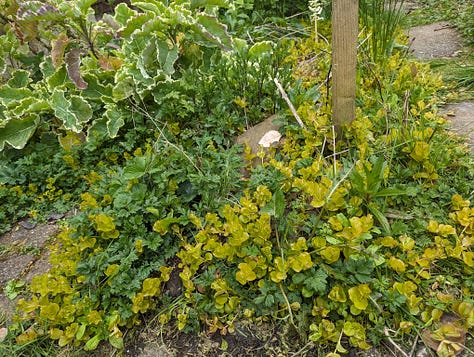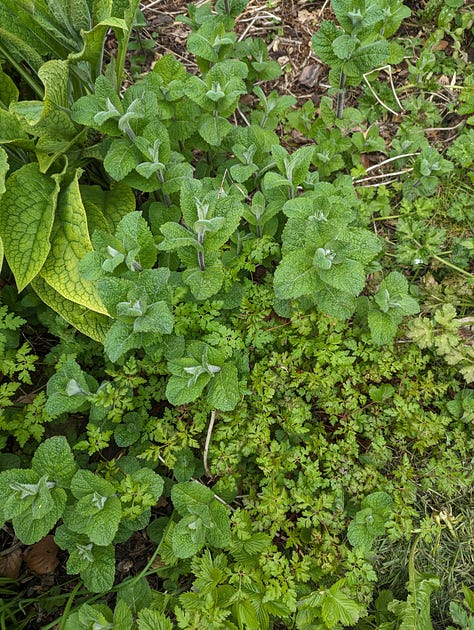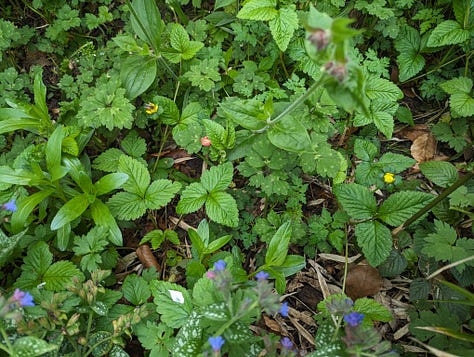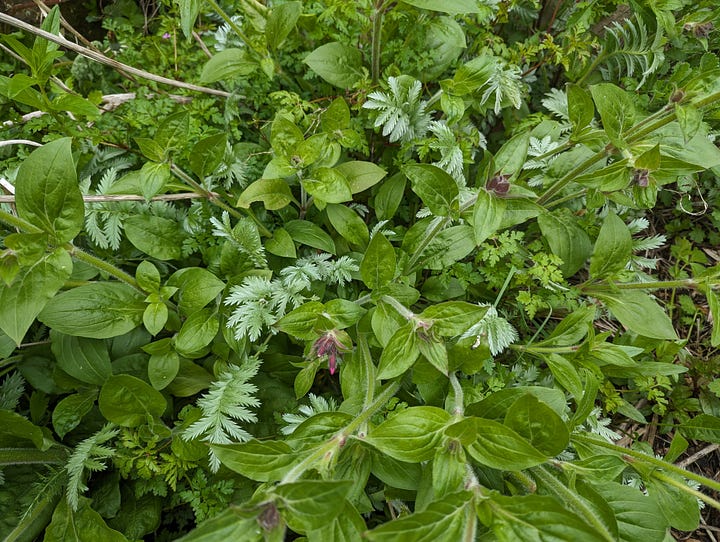Back from my hiatus, I’ve been thinking about the perpetually present “weedy” plants in my garden. Way back before I got into this Permaculture lark, when I had just dived into gardening, I was pulling certain plants out over and over. I wondered when these plants would go away and leave me nice clean bare soil between my preferred ornamentals.
I’ll list these weedy plants to clue you in
Herb-Robert, Geranium robertianum, a low growing, shallow rooted, prolifically seeding annual (or biannual) Geranium with petite pink flowers that smells like burnt rubber when pulled
Forget Me Nots, Myosotis sylvatica, a famous electric blue, short-lived, perennial flowering plant that bears seeds in little pods that are easily brushed off
Creeping Buttercup, Ranunculus repens, spreads like strawberries, rooting as it goes. Suddenly surges in height when it decides to open its yellow buttercup flowers
Red Campion, Silene dioica, after the electric pink flowers are pollinated, the seeds rattle around in prolific number
Rosebay Willowherb, Chamaenerion angustifolium, pink spikes of flowers give way to the lightest of fluffy seed heads, like dandelions but possibly even lighter
You’ve likely heard the adage, a plant is a weed only if you don’t want it there, and that is indeed true. How dare some creeping buttercup start spreading on my bare soil?
Even recently, as I’ve trying to cultivate my forest garden, they kind of get in the way. Here I am, trying to establish some Good King Henry or Caucasian Spinach and these thugs rock up, climbing all over my fledgling edibles. Don’t you weeds understand that I’m trying to set up an edible food forest? How ignorant of them.
Recently, I decided to take a different tack. I decided to fight fire with fire (not literally). If I can’t get a grip on these “weedy” plants, I will add other invasive plants. Let’s see how these weedy plants cope with a taste of their own medicine.
“Weedy” plants I decided to add to the chaotic mix include:
Apple Mint, Mentha suaveolens, a familiar, fragrant, edible herbaceous that is often maligned for spreading everywhere
Mock Strawberry, Potentilla indica, a creeping plant that spreads and looks like strawberry, down to the red fruit. I sourced this from a friend’s garden
Wild Strawberry, Fragria vesca, a random stray that was growing through a hole in my fence from my neighbour’s garden.
Lesser Celandine, Ficaria verna, beautiful early yellow flowers that spreads outwards from a single clump
Common Silverweed, Argentina anserina syn. Potentilla anserina, does this plant need any introduction?
Sweet Woodruff, Gallium odoratum, a shade loving low growing plant with pleasant white flowers that spreads by underground stolons.
Bugleweed, Ajuga reptans, a vigorous spreading herb with purple flower spikes.
Three-cornered Garlic, Allium triquetrum, found at my allotment and brought back to my garden. This is supposedly a vicious little spreader but because its a completely edible garlic substitute I guess I don’t mind.
And just this week, the penny finally dropped. The real problem with these so-called weedy - and dare I say the word “invasive” - plants is the lack of harmony.
They stick out because they have an outsized contribution to the ecosystem.
They stick out because they grew up in a different neighbourhood and the choice we have now is what type of welcome we give them.
What I mean is that “invasive” plants are several degrees more vigorous than other plants in the ecosystem they find themselves in.
In bringing many plants with high vigour together, what I’m doing is creating a vibrant ecosystem together.
I full expect these plants to go to war until they’ve found their niches, but the end result will be some kind of equilibrium where each plant is happy in their role. Some will be completely out competed, but that is life.
And I guess this is the crux of it. Arguments about invasiveness are rooted in the belief that this collection of plants are meant to be together, and that collection of plants don’t.
Just remember, though, these collections (ecosystems) got that way through change, and will continue to change.
Evolution of ecosystems makes sense through the ever-grinding gears of time.
Ecosystems are not stagnant, frozen communities in time.
As to my collection of super vigorous, invasive plants?
Right now, I can tell you that the Bugleweed has monopolised the area around the lower mini-pond and the Wild Strawberry coexists with the Apple mint under the apple tree.
The Mock Strawberry has had its first contact with the Creeping Buttercup under pearlbush and seems to be flowering - an indication of either stress or contentment, time will tell!
The Lesser Celandine has faded in the warming weather but I expect it to rebound next year. The Silverweed needs no help and is romping away in all areas.
The Three-cornered Garlic has been planted in my tulip patch in my front garden. This bed is constantly being invaded by grass anyway.
The Sweet Woodruff has just been planted but appears to love the shadiest spot of the garden. Time will tell what happens when it meets the Bugleweed that is reaching its tendrils all over that bed.
All this talk about invasive and native, whatever you may think, try telling it to this nectar drunk and pollen covered Honey Bee prostrate on a Mock Strawberry flower.










We once gave a workshop called embrace your weeds. :) The best feedback we got was -- Now I'm not so angry when I'm weeding.
We had herb Robert growing over our 2 year old fruit bushes this year. Not sure on the long term and the bushes will get taller but this year it protected the minimal fruit from being seen by birds